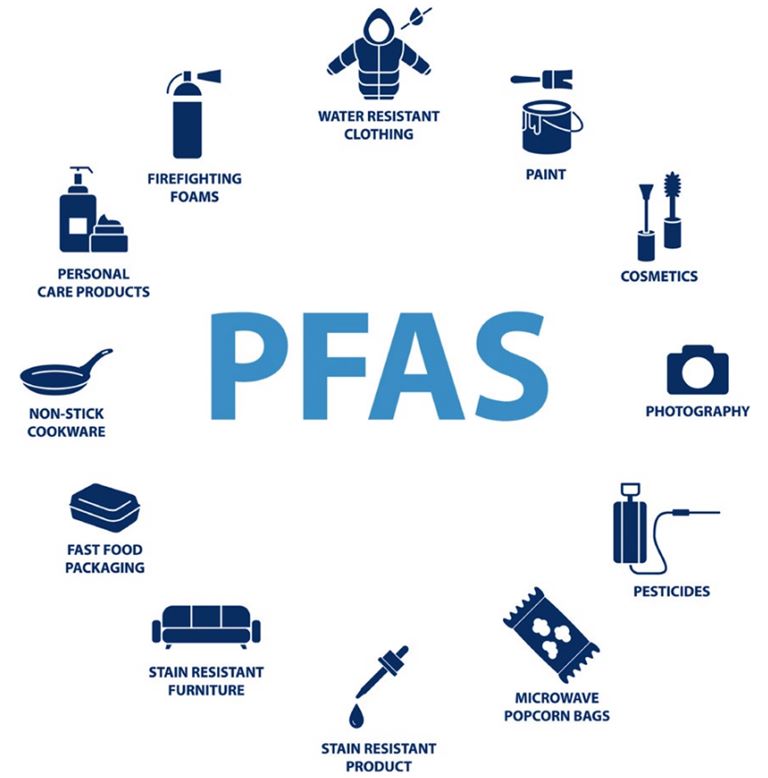Unseen Peril: Forever Chemicals (PFAS) Quietly Impacting Businesses and Industries
ArticleMay 17, 2023
Perfluoroalkyl and polyfluoroalkyl substances (PFASs) have permeated diverse industries, fuelled by their exceptional properties like minimal surface tension, resistance to heat and chemical breakdown, and repellency to water and oil. While PFASs find prominent use in aqueous film forming foams, textiles, and food packaging, their presence in lesser-explored domains such as cosmetics, dental restorative materials, and dirt-repellent coatings for smartphones remains an understudied concern.

Over the past decade, a number of scientific findings has demonstrated the persistent, bio accumulative, and toxic nature of certain PFASs to both wildlife and humans. A seminal study, funded by the Nordic Council of Ministers and published as early as in 2004, shed light on the pervasive presence of select PFASs, particularly the enduring Perfluoroalkyl acids (PFAAs), within the Nordic environment. Esteemed by the scientific community and regulators alike, this report served as a crucial catalyst, prompting national monitoring initiatives in Nordic countries and contributing to the regulatory measures against Perfluorooctane Sulfonate (PFOS). While the use of detrimental PFASs like PFOS and Perfluorooctanoic acid (PFOA) has gradually diminished in recent years, their substitutes often come in the form of alternative PFASs, typically characterized by shorter carbon chains or distinct functional groups. Today, it is estimated that over 4,000 highly fluorinated substances circulate within the global market, casting a daunting shadow.
A study in 2019, funded by the Nordic Council of Ministers and published in 2019, conducted a screening study of in all ninety-nine conventional and emerging per- and polyfluoroalkyl substances (PFASs) in the Nordic environment. It covered a total of 102 samples in all, including air, surface water, fish, marine animals, terrestrial mammals, bird eggs, and wastewater and sludge. Institutes from the participating countries and self-governing territories, including Denmark, the Faroe Islands, Finland, Greenland, Iceland, Norway, and Sweden, gathered the samples. The outcomes of this comprehensive screening study emphasize the priority to broaden the scope of environmental assessments to encompass a wider range of PFAS classes.
Remarkably, several novel PFASs were discovered in biota, water, and air samples during this investigation. Considering the extensive array of PFASs available in the global market, it is highly plausible that additional PFAS variants are yet to be unveiled in environmental samples. Analysis of extractable organic fluorine revealed a substantial portion of unidentified extractable organofluorine within the Nordic environment.
Conclusion
As these forever chemicals have become prevalent in numerous industries, it is imperative to take some time to determine whether PFAS compounds are present in your activities. It is also beneficial to go through potential consumer, worker, and environmental exposure scenarios. Analyze the areas of products and packaging where PFAS can be eliminated. Consider ways to stop using PFAS-containing foam when firefighting foam systems are in operation and assess the characteristics offered for foam containment. Finally, be prepared for potential PFAS reporting requirements that local, state, and federal regulators may impose and think about the business repercussions of consumer or public response. Obtain legal counsel and risk management advice to best navigate through a potentially difficult planning process.
Additional considerations
During this planning process, companies should consider what business and social risks may apply. Possible exposure scenarios relating to workers, consumers and the environment should be considered. Understanding to what extent you may have PFAS substances in your stream of commerce – including raw materials, supply chain risks, storage, distribution, and disposal through an inventory of PFAS – will provide you an overview of possible exposures.
Acquiring and review of Safety Data Sheets can be cross-referenced against the EEA’s (the European Environment Agency) PFAS chemical list. With expanding regulatory oversight on PFAS products, it is important to understand how regulations may affect your company’s business model. Once it is known where and how the company may be exposed to PFAS, preparations for needed actions can be made. Consider supply chain risks and how you will operate in the event that certain components become unavailable or certain products can no longer be sold. Companies should anticipate possible PFAS reporting requirements through regulators and business consequences of reactions by customers or the public. Companies should be aware of the increasing prevalence of claims arising out of PFAS exposures or contamination. Develop a communication plan to inform key customers, consumers, suppliers, and other key stakeholders in advance disclosures. Ensure that your company has identified who will respond to PFAS inquiries.
Zurich Resilience Solutions can help with addressing the rapidly changing risk landscape, with a new, truly holistic approach to supporting your risk management and helping you to build your resilience. We will be able to pre-empt your needs and equip you to take prompt measures to tackle challenges before they can develop. For more information contact Manish Bhanu, Risk Engineer at Zurich Nordic.
References:
- PFASs in the Nordic environment. Anna Kärrman, Thanh Wang and Roland Kallenborn, 2019.
- Perfluorinated alkylated substances (pfas) in the Nordic environment. Kallenborn R, Berger U, Järnberg U, Dam M, Glesne O, Hedlund B, et al. 2004.
- NFPA 11. Standard for Low-, Medium, and High-Expansion Foam. Quincy, MA; NFPA, 2016.
- Nordic enforcement project on PFOS and PFOA in chemical products and articles. Petteri Talasniemi, Sara Björkqvist, Maryam Ashja, Amanda Rosen, Christian Iversen, Bergdís Björk Bæringsdóttir, 2022.
